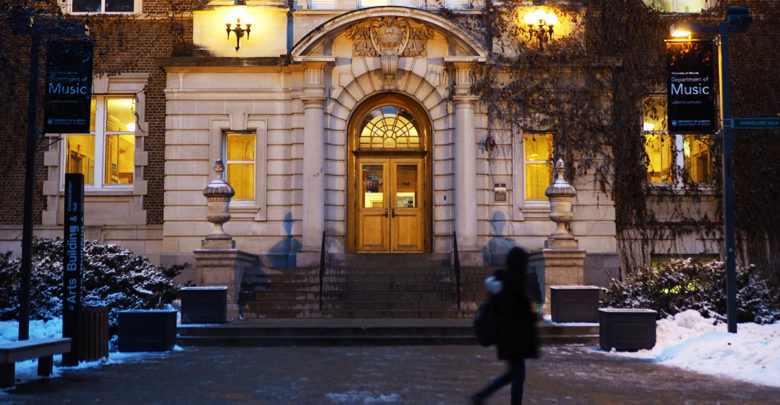Student panels critique academic restructuring, suggest ways for students to take action
The November 19 and 20 panels, hosted by the University of Alberta’s department of sociology, brought students together to discuss the potential impacts of restructuring on the student experience and ways for students to make their voices heard.
 Helen Zhang
Helen ZhangAmidst the University of Alberta’s ongoing restructuring debate, a recent event from the department of sociology took a deep dive into the potential impact of restructuring on the student experience.
The event included two student panels on November 19 and 20. Each panel featured a group of student speakers including Students’ Union vice-president (academic) David Draper and vice-president (student life) Katie Kidd, as well as Marc Waddingham, president of the Graduate Students’ Association (GSA). Both panels focused on the potential impact of restructuring and what students could do in response to these emerging changes.
While the U of A had been planning to restructure before the provincial government cut funding to post-secondary institutions in 2019 and again in 2020, the restructuring project has become the principal way the university intends to mitigate these losses.
Speakers discussed both academic restructuring, which encompasses the consolidation of faculties under the U of A for Tomorrow plan, and administrative restructuring, which encompasses changes to the way services like academic advising are organized.
Administrative restructuring is being overseen by the service excellence transformation (SET) initiative.
Students unpack potential impact of restructuring on student experience
Several of the panelists drew attention to the fact that rising class sizes, increased enrollment, and fewer course offerings are all features of restructuring that will negatively impact the student experience.
Meagan McLay, a fourth-year undergraduate criminology student, noted that these changes, alongside the pressure to provide more students with degrees as a result of future performance-based funding could mean that the quality of learning will take a back seat.
“Professors will have less time for each individual student,” McLay said. “There’ll be less of an interactive engagement, rather students will be pushed through classes.”
Manzah-Kyentoh Yankey, a sociology graduate student, pointed out that impending tuition raises — a seven per cent increase per year — mean students will end up paying more for services that are ultimately poorer in quality than those in previous years.
“Instead of getting what we pay for, we’re going to pay more for what we’re not going to get,” she said.
Others, like Hassan Nawab, a fifth-year honours psychology student and founder of student advocacy group Active Minds, focused on the ways that restructuring will impact student mental health. Nawab shared that he already sees U of A counselling and clinical services overloaded, a problem that increased enrolment would only exacerbate.
“Every student at the U of A deserves an enriched university experience,” he said. “When that cannot happen, especially when it eats up elements that are so crucial to student wellness … then we’re heading for a recipe for disaster.”
Panels weigh in on perceived benefit of restructuring
While both panels were almost unanimously skeptical of the restructuring process, elected student representatives generally shared more optimistic views of restructuring.
Katie Kidd, Students’ Union vice-president (student life), said that the consolidated student services centre described by the SET initiative was something that could benefit student experience.
“You will have several points of access and the people who you’re going to are knowledgeable about what the services are,” she said. “It shouldn’t be that you’re desperately googling U of A sexual violence to figure out where to go for what situation. It should be easy to understand.”
Similarly, Marc Waddington, president of the Graduate Students’ Association (GSA), shared that restructuring provides a unique opportunity for students.
“A degree and range of conversations about the U that A we want to see, about the changes we need to have happen here are now finally starting to come in,” he said. “We’re finally starting to see something like a reformation where we might be able to analyze the culture of the place, of the way of doing things, and if there’s not a more equitable or better way of doing it.”
Others, like Maura Roberts, a second-year political science student and member of the Graduate Student Collective — an organization composed of a group of students committed to organizing to express their dissent with restructuring — elaborated on why they wouldn’t be looking at this as a particularly beneficial moment any time soon.
“We shouldn’t get this twisted,” Roberts said. “We shouldn’t be thinking that there’s real attention to calls for Equity, Diversity, and Inclusion beyond lip service.”
Gurbani Baweja, a software engineering student, also questioned messaging surrounding restructuring that made claims to a goal of improvement.
“It makes sense if we were doing it for better program choices, however in our case, the sole motive of restructuring is to cut down the costs,” she said. “In some places it’s being carefully represented as enhancing the experience of students.”
Panelists suggest ways for students to take action
Emily O’Neil, a graduate student in women and gender studies, gave a presentation informing students about how they can get involved by joining the Graduate Student Collective, of which she, — like Roberts — is a member.
She explained that while the collective began with graduate students in mind, O’Neil said that it welcomes undergraduate participation, as well as collaboration with academic and non-academic staff.
“There’s a lot of power in organizing around a mutual desire to keep our voices on the table and speak out when proper consultation is not being had,” she said.
Kidd noted that she has observed students show a lack of concern about restructuring. She recommended that students reach out to their representative on the General Faculties Council (GFC), the highest academic legislative body at the U of A that has the ability to vote on the restructuring proposals.
“This is the number one way you can effect change,” she said. “As a former education student councillor, no one ever emailed me about anything, so you know that if I received an email, I would take an issue more seriously.”
“The biggest problem that we see is that there’s student apathy,” she said, “If you are passionate about something, reach out to your representatives, because they are the ones who have the direct connection to the administration.”
Roberts presented a different picture of student responses to academic restructuring.
“For the most part, there’s immense dissatisfaction across the board and that includes not just graduate students — that’s undergrads, teaching staff, faculty, and administration,” they said. “There needs to be some kind of platform to see this discontent. If it’s not there, it seems like acquiescence, and I’ve gone to a number of meetings that suggest that people at the U of A are anything but acquiescent.”
Like O’Neil, Roberts mentioned the Graduate Student Collective they are a part of as a potential next step for those looking to take action and make their voice heard.
“Tag on to the collective, we would love your support, we would love to be involved in it,” they said. “Then you can say that you are the collective too.”




